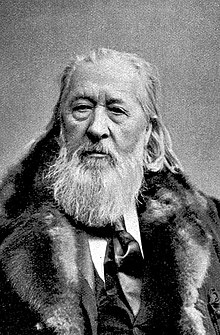Johann Jakob In the courtyard
Johann Jakob Im Hof (born March 6, 1815 in Basel ; † June 7, 1900 there ) was a Swiss businessman , politician and art patron .
life and work
Johann Jakob Im Hof was the son of the judge and tannery owner Johann Jakob Im Hof (1786–1848) and his first wife (1788–1817) Margaretha Steiger. According to his father's wishes, he had to train as a businessman, but was allowed to pursue his real interests: technology and art.
So Im Hof took his first drawing lessons from Achilles Benz. Later he was a student of Hieronymus Hess for a short time , whose biography he published sixty years later. When he went to school in Lausanne , he was a student of Jean-Pierre Naef.
Im Hof was a merchant in Paris in 1836/1837 and had meanwhile found great interest in the military. There he learned topographical drawing from Johann Georg Heck , specifically for later use for military use, and often visited the Musée de l'Armée . In December 1836, when King Louis-Philippe I was assassinated , he was briefly detained in the courtyard as a suspect.
When he returned to Basel, he was able to apply his knowledge in the commercial, political and military fields. In 1843 Im Hof became a member of the city police court as well as the civil and appeal court. When a typhus epidemic raged in Basel in 1865/1866 , Im Hof, as head of the health department, organized the necessary steps to put a stop to the epidemic. As a free-spirited , liberal politician, he was elected to the Small Council in 1858, of which he was a member until 1866. Im Hof was highly regarded as a major in the general staff and as the owner of his own tannery. The tanners' guild elected him to the guild board in 1853 and from 1869 to 1881 he was the guild master.
In 1842 Im Hof joined the newly founded Basler Künstlergesellschaft (BKG) and took over its presidency for the next 26 years, which he retained after the merger with the Basler Kunstverein in 1864. In 1854 he campaigned for the Basler Ferry Company to be founded in order to finance a long-awaited “artist house” , which later enabled the Kunsthalle Basel to be built.
It was also thanks to Im Hof's commitment that the St. Jakobs monument and the Hebel monument could be realized. In the courtyard was on friendly terms with many artists of his time, u. a. with Rudolf Koller , Arnold Böcklin , Richard Kissling and above all with Ferdinand Schlöth , to whom he also commissioned a portrait bust in 1880.
In 1872 he traveled with his daughter and two architects via Milan , Florence , Pisa , Siena , Rome and Naples to Capri . In Rome he met many artists a. a. with Ernst Stückelberg , August Weckesser and Anselm Feuerbach . He visited Paris several times, where he also had contact with local artists.
Maria Forcart (1819–1871) was married in the courtyard for thirty years. Together they had several children, some of whom died in childhood. He later married the widow Amalia Rüsch, née Jakob (1831–1911). From 1864 he lived in the Basel city palace, Haus zum Kirschgarten .
Publications
- Johann Jakob Im Hof: The history painter Hieronymus Hess von Basel - history of his life and directory of his works. Basel, 1887. Digitized version of the Badische Landesbibliothek
literature
- Stefan Hess , Tomas Lochman (ed.): Classical beauty and patriotic heroism. The Basel sculptor Ferdinand Schlöth (1818–1891), catalog for the exhibition of the same name in the Basel Sculpture Hall. Basel 2004, ISBN 3-905057-20-4 .
- Stefan Hess: Between Winckelmann and Winkelried. The Basel sculptor Ferdinand Schlöth (1818–1891). Berlin 2010, ISBN 978-3-86805-954-0 .
- Jakob Probst: Councilor JJ Im Hof 1815–1900 . In: Basler Stadtbuch 1902, pp. 24–44.
Web links
- Johann Jakob Im Hof In: State Archives Basel-Stadt
- Pedigree of JJ Im Hof in stroux.org
Individual evidence
- ↑ Benz, Achilles. In: Sikart
- ↑ Naef, Jean-Pierre. In: Sikart
- ^ Basler Kunstverein, Basler Fähregesellschaft, Kunsthalle Basel
- ↑ To the bust, today owned by the Basler Kunstverein, cf. Stefan Hess: Between Winckelmann and Winkelried. The Basel sculptor Ferdinand Schlöth (1818–1891). Berlin 2010, p. 180, no. 56.
| personal data | |
|---|---|
| SURNAME | In the yard, Johann Jakob |
| ALTERNATIVE NAMES | In Hof-Forcart-Rüsch, Johann Jakob |
| BRIEF DESCRIPTION | Swiss businessman, politician and patron of the arts |
| DATE OF BIRTH | March 6, 1815 |
| PLACE OF BIRTH | Basel |
| DATE OF DEATH | June 7, 1900 |
| Place of death | Basel |
